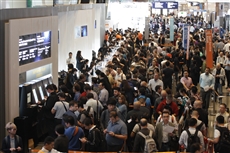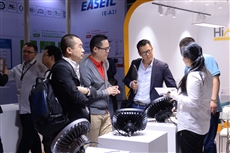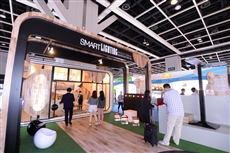HKTDC April Fairs Welcome 224,000 Buyers and Bring in More Than HK$1.2 Billion
11 May 2016 – A total of nearly 224,000 buyers attended seven fairs organised by the Hong Kong Trade Development Council (HKTDC) in April, a slight increase over the previous year. Buyers from the Chinese mainland and overseas numbered close to 126,000, accounting for 56 per cent of the total buyer attendance. The seven fairs included: Hong Kong International Lighting Fair (Spring Edition), Hong Kong Electronics Fair (Spring Edition), International ICT Expo, Hong Kong Houseware Fair, Hong Kong International Home Textiles and Furnishings Fair, Hong Kong Gifts & Premium Fair and Hong Kong International Printing & Packaging Fair which was jointly organised with CIEC Exhibition Company (HK) Limited.
Buyer trends spotlighted
The number of buyers from some emerging markets increased. Growth was seen in the number of buyers from ASEAN countries such as Malaysia (up 10%) and Brunei (up 19%). Satisfactory growth was recorded in buyers from certain European emerging markets, such as Greece and Hungary which registered year-on-year increases of 16 per cent and 15 per cent respectively. Buyers from Latin America registered one per cent growth compared to the previous year, while those from the mainland continued their upward trend, increasing five per cent compared to last year. Noteworthy growth was also seen in the number of buyers from the more than 60 countries covered by the Belt and Road, which accounted for nearly 40 per cent of total buyer attendance at the April fairs, up two per cent over the previous year.
Consumer demand in traditional markets remains volatile due to the uncertain global economic conditions. However, some Nordic countries have emerged as a driving force for growth with relatively strong consumer demand in the region prompting more buyers to visit the HKTDC’s fairs. Buyers from Denmark and Norway rose 15 per cent and 10 per cent respectively. Elsewhere in Europe, buyer attendance from the United Kingdom was up 3.6 per cent and Italy rose 2.7 per cent year-on-year. From North America, Canadian buyers increased by 1.8 per cent.
“In the face of uncertain global market conditions, traders should promote and source competitive, innovative products more proactively,” said HKTDC Deputy Executive Director Benjamin Chau. “The steady attendance at the seven HKTDC April fairs shows that buyers are adopting this strategy. It also demonstrates that Hong Kong is an important promotion and sourcing platform for traders. The fairs have also made an enormous economic contribution to Hong Kong’s economy.” According to the Hong Kong Tourism Board, per capita spending of overnight MICE visitors averaged HK$8,426 during their stay. Based on this figure, the total amount spent by overseas buyers and exhibitors during the seven April fairs would have amounted to more than HK$1.2 billion, excluding trade orders and spending on related business services.
Mr Chau added that, in response to the buyer trend towards small and frequent orders, the HKTDC set up the hktdc.com Small Orders display at the Lighting, Electronics, Houseware and Gifts & Premium Fairs, featuring a total of 1,100 showcases with more than 8,500 products, generating over 70,000 business connections.
Industry cautious about prospects; Intensifying cost pressures difficult to transfer
Gathering exhibitors and buyers from around the world each year, the April fairs serve as a barometer for market sentiment and product trends. The HKTDC commissioned independent on-site surveys during the Lighting, Electronics, Houseware and Gifts & Premium Fairs. A total of more than 2,600 exhibitors and buyers were interviewed. The surveys found respondents to be generally cautious about market prospects in the year ahead. Forty two per cent of respondents expect sales to remain steady, with 31 per cent expecting overall sales to grow. Exhibitors and buyers also anticipate cost pressure challenges in the coming year and they believe it will be difficult to transfer the increased production costs to consumers. Twenty four per cent of buyers interviewed expect sourcing costs to rise. Among the exhibitors interviewed, 25 per cent expect FOB (Free On Board) selling price to increase, 55 per cent expect FOB selling price to remain unchanged and 18 per cent expect it to fall.
North America leads traditional markets; Chinese mainland continues to shine
The on-site surveys also sought exhibitors’ and buyers’ views on the growth prospects of different markets. Most respondents said North America is the most promising among traditional markets, followed by Australia and New Zealand. As for emerging markets, respondents were most optimistic about the mainland, ASEAN and other Asian countries (Please see appendix below).
The exhibitors’ identified specific emerging markets for their export strategies. Twenty per cent of exhibitors interviewed consider the mainland and ASEAN to be major emerging export markets, up 15 percentage points and 13 percentage points respectively compared to the findings in last year’s survey.
Smart tech drives electronics and lighting markets
Regarding product trends of different industries, the surveys found that smart technologies are expected to play a key role in the electronics and lighting industries. Survey respondents at the Electronics Fair generally agreed that the market for electronics/electrical accessories will continue to grow. They also expect the trend for smart devices to move towards high-end models, with more than 80 per cent of respondents saying they believe consumers would be willing to pay a premium of up to 20 per cent for electronics and household appliances with smart home applications. As Internet of Things (IoT) technology continues to develop and smart homes become more prevalent, which will stimulate the demand for different types of products. Respondents identified product categories with best growth prospects as: systems items for connections with Internet/mobile network (wireless and Wi-Fi) (73%), audio-visual items with smart functions (72%) and wireless charging devices for smart applications (70%) Sixty-four per cent of respondents expect smart devices for energy management and saving to benefit from new developments in IoT. Other product categories favoured by the respondents include smart lighting apparatus and home security/alarm systems.
For the lighting industry, the widespread use of smartphones and tablet computers will continue to play a key role in product development. Ninety-two per cent of respondents interviewed at the Lighting Fair believe that the development of smart technologies will facilitate the lighting industry in the coming two years. Most respondents (49%) expect household lighting systems that are compatible with, or can be controlled by, smartphone/tablet applications to have the greatest growth potential, followed by smart, energy-saving lighting systems for household/industrial/commercial purposes (46%) and industrial/commercial lighting systems that are compatible with, or can be controlled by, smartphone/tablet applications (26%).
Trends in Gifts and Houseware
At the Gifts & Premium Fair, most respondents said figurines and decorations have the strongest growth potential this year (13%), followed by tech gifts (12%), fashion jewellery & accessories (10%) and advertising gifts and premium (10%). At the Houseware Fair, eco-friendly products (16%), kitchenware and gadgets (14%) and interior décor and handicrafts (12%) were seen as the most promising products in the market.
Major product trends:
|
Lighting |
|
|
Electronics |
|
|
Gifts & Premium |
Figurines & decorations (13%), tech gifts (12%), fashion jewellery & accessories (10%) and advertising gifts and premium (10%). |
|
Houseware |
|
Traditional markets with the greatest growth potential, according to exhibitors and buyers*
|
|
Market |
|
First |
North America |
|
Second |
Australia & New Zealand |
|
Third |
Western Europe |
Emerging markets with the greatest growth potential, according to exhibitors and buyers*
|
|
Market |
|
First |
Chinese mainland |
|
Second |
ASEAN countries |
|
Third |
Other Asian countries |
* Respondents: 2,611 (including exhibitors and buyers)
|
|
The seven fairs organised by the HKTDC in April gathered a total of more than 12,000 exhibitors and around 224,000 buyers. Mainland and overseas buyers accounted for nearly 126,000 visitors |
|
|
Based on the number of overseas buyers and exhibitors who attended the seven April fairs, the economic contribution made by the fairs to Hong Kong amounted to more than HK$1.2 billion |
|
|
Buyers from the Chinese mainland continued to increase, with attendance up five per cent over the previous year |
|
|
70 per cent of Electronics Fair visitors surveyed were positive about the prospects for wearable electronic products in the coming two years |
|
|
92 per cent of respondents interviewed at the Lighting Fair believe that the development of smart technologies will facilitate the lighting industry in the coming two years. Most respondents expect household lighting systems that are compatible with, or can be controlled by, smartphone/tablet applications to have the greatest growth potential |
Media Enquiries
Please contact the HKTDC's Communication and Public Affairs Department:
Joe Kainz Tel: (852) 2584 4216 Email: joe.kainz@hktdc.org
To view press releases in Chinese, please visit http://mediaroom.hktdc.com/tc
About the HKTDC
A statutory body established in 1966, the Hong Kong Trade Development Council (HKTDC) is the international marketing arm for Hong Kong-based traders, manufacturers and services providers. With more than 40 offices globally, including 13 on the Chinese mainland, the HKTDC promotes Hong Kong as a platform for doing business with China and throughout Asia. The HKTDC also organises international exhibitions, conferences and business missions to provide companies, particularly SMEs, with business opportunities on the mainland and in overseas markets, while providing information via trade publications, research reports and digital channels including the media room. For more information, please visit: www.hktdc.com/aboutus.






